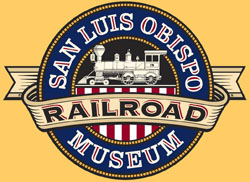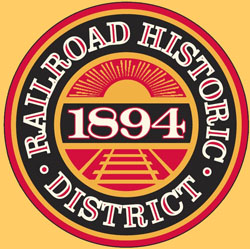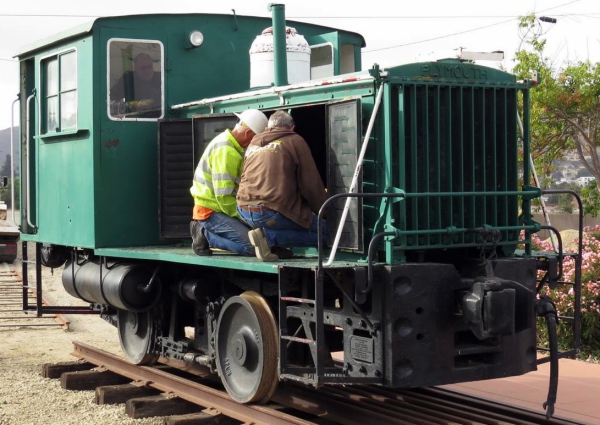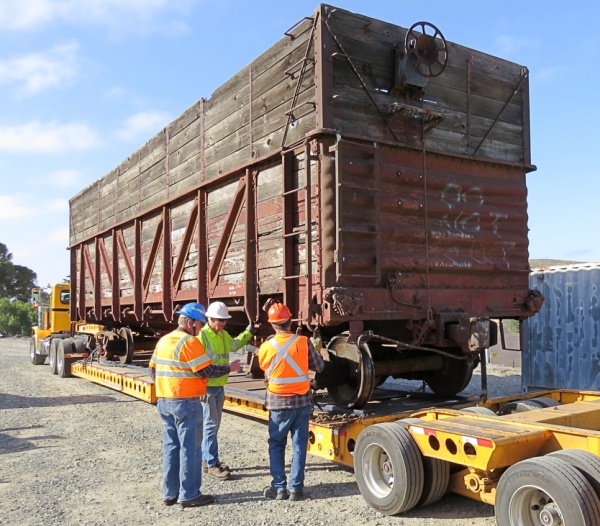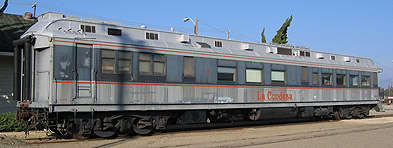Rolling Stock
Plymouth Diesel Switcher #2038. This Plymouth 20-ton switcher was purchased by the Army Corps of Engineers and delivered in April 1941 to develop and supply Camp Roberts, near San Miguel. Operated by the Quarter Master Corps as #Q.M.C. 2038, the locomotive switched railroad cars of munitions and supplies for over 430,000 soldiers who were trained at the camp during World War II. More...
Southern Pacific Railroad Sugar Beet Gondola Car. This is Southern Pacific Railroad 358973 which was built in 1949 by Southern Pacific and used on the west coast for decades to move beets to Betteravia. It was donated to the SLORRM by the Western Railway Museum in Rio Vista California. More...
La Cuesta 1926 Pullman Observation, Ex Santa Fe No. 1512. La Cuesta, formerly known as La Condesa, a 1926 Pullman observation open platform car was donated to the museum by member Gordon Crosthwait in June of 2006. More...
Pacific Coast Railway Boxcar 1200 Series. The museum's Pacific Coast Railway narrow gauge 1200 series car was built by the American Car and Foundry Company in 1924 for the PCRwy. More...
Pacific Coast Railway Boxcar 706. This 30-Foot boxcar is one of a group of 10 boxcars built circa 1906-1912 by Pacific Car and Foundry in Seattle, Washington. More...
Southern Pacific Railroad Tank Car. This tank car was designed by the Southern Pacific Railroad and the Standard Steel Car Co. The car was built in 1903 by the Standard Steel Car Co. to a Common Standard design. More...
Southern Pacific Bay Window Caboose No. 1886. Southern Pacific Bay Window Caboose number 1886 was built in June, 1972. It was last used by SP on the Lompoc Local. More...
Southern Pacific Boxcar Class B-50-13. Circa 1926 Southern Pacific wooden boxcar class B-50-13. Donated to the museum by Glen McElroy, CEO of Pick-Your-Part Salvage Yards in June, 2001. More... Also, see its move down the track on 2/27/2020.
Southern Pacific Caboose #244, Class C-30-1. This caboose was purchased by the Museum and was moved to the Emily Street yard in 2013. It was moved from the high desert north of Lancaster, CA where it had been since 1963. The car was built in 1926. You can read all about the 2013 move in the Summer 2013 newsletter and the Fall 2013 newsletter. Photos of its 2023 move from the Emily Street Yard to the Museum's display track are here.
Other Railroad Equipment
Southern Pacific Fairmont MT-19A Inspection Car. This is a fully-restored Southern Pacific Fairmont MT-19A inspection car. Research shows this model was made between 1966 and 1986. More...
Northwest Motor Company Speeder. This motorcar is a Model 532R that was built in the 1950s by the Northwestern Motor Company of Eauclaire, Wisconsin. The SLO Railroad Museum acquired this car from a railroad collector in Terra Bella, California. Makes a great photo opp! More...
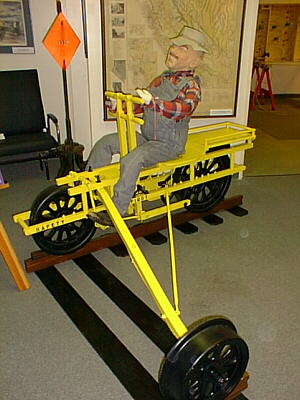
Southern Pacific MOW Velocipede. In 1883, George S. Sheffield of Three Rivers, Michigan invented the Sheffield
Velocipede handcar, a 140 lb. vvood and iron bicycle with a third wheel for
balance. The car is powered by both hand and foot levers. He soon formed the
Sheffield Velocipede Car Company and produced about 4,000 cars. The velocipede
was used throughout the nation and Europe for railroad signal inspection and
maintenance. This particular handcar was used locally in San Luis 0bispo on
Southern Pacific rails in the early turn of the century. PDF Poster
Phil Gould, a member of the San Luis 0bispo Railroad Museum, has lovingly
restored this velocipede from it's original condition over the course of six to
eight months. We thank both Phil and Vera, his wife, for their outstanding
effort in reconstructing this historic rail vehicle. More...
Southern Pacific Hand Car. This Sheffield Car Company hand car was purchased by the Southern Pacific Railroad for use in Southern California. Southern Pacific Railroad began using a "Safety Orange" paint of their specific tint in the late 1930's. More...
Wig Wag Crossing Signal. The "Magnetic Flagman" or Wig Wag Signal, as it is commonly known, was seen all over California and the western states. It was designed by Albert Hunt of the Pacific Electric Railway in 1909. More...

Southern Pacific Baggage Carts. Original Southern Pacific baggage carts, circa 1940's, that were used at the San Luis Obispo railroad station. They were used for baggage, freight and milk can loading and unloading at the Depot. Donated by Amtrak to the Museum.
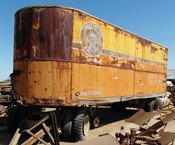
Southern Pacific Railroad Pacific Motor Trucking Trailer (#3009) in Daylight colors. This was acquired by SLORRM thanks to a donation by Brad LaRose. This is a 22-foot, round front-end trailer, with a towing dolly and a single axle in the rear with dual wheels. The trailer was made by Trailmobile in 1934 and last used (based on DMV registration) in 1957. More...
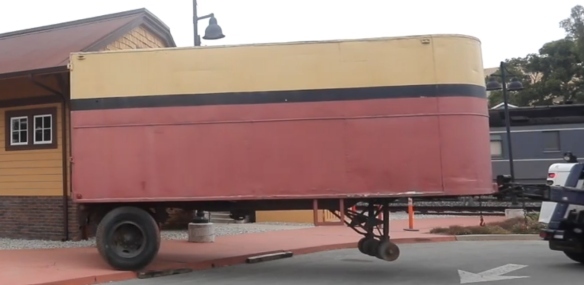
Southern Pacific Railroad Pacific Motor Trucking Trailer. 22 feet, Daylight painted. This is the second such trailer acquired by the SLORRM and the plan is to have both of these trailers put on a Southern Pacific flat car just as would have been done when they were in service, TOFC (Trailer on Flat Car). See a SLO Tribune video. Also, see Brad's video with more information and donation request. You may donate to this project on our donations page.
Gone, but Not Forgotten
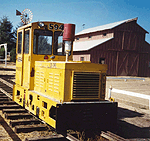
Plymouth Locomotive #594 was donated to the Museum in 1999 by Brad and Patti LaRose. Built in 1968 in Plymouth, Ohio, #594 is powered by a six-cylinder International Harvester gasoline engine, connected to a hydraulic charge pump, which drives a 5-cylinder variable speed hydraulic motor. Power is transmitted to the wheels via chains on sprockets. This unit was sold and is no longer a part of the Museum's collection.
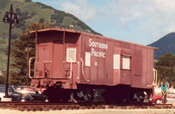
Southern Pacific Bay Window Caboose No. 409. Caboose 409 was built by American Car & Foundry of Chicago, Illinois in 1947. It was first assigned to the Texas & New Orleans Railroad and later transferred to the Southern Pacific. For many years 409 sat in Templeton Community Park where is was used as an office by the Templeton Chamber of Commerce. It was donated to SLORRM in January 2002. In the Spring of 2014, it was sold and moved to a spot just north of the museum building next to Railroad Square.
